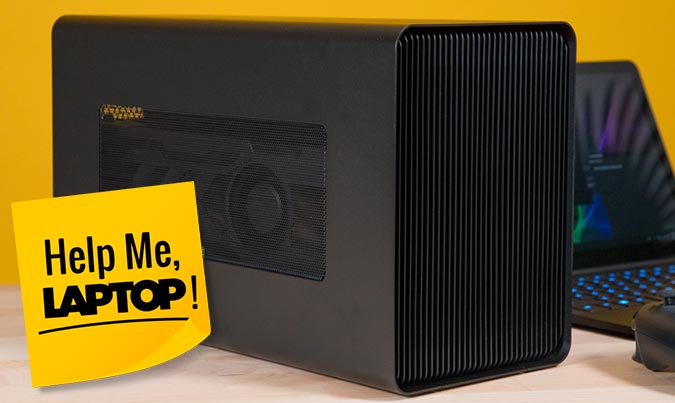Should You Buy a Budget Gaming Laptop, a High-End Laptop or an eGPU?
If you want to consistently update your gaming rig, odds are, you're going to want a good gaming desktop. But a desktop machine isn't an option for some people, either because of a lack of space or a desktop's relative immobility. If you need reliable gaming specs crammed into a laptop-sized package, there are a few options.
Reader crawford.fergus needs a long-term gaming laptop and is deciding among three options: 1) Buy a budget laptop and replace it once in a while, 2) Go with a future-proof, hard-core gaming laptop or 3) Invest in an eGPU enclosure to supplement an affordable laptop with a killer CPU and weak GPU.
Right away, let's discard the eGPU enclosure option. While it sounds good on paper, given that built-in laptop GPUs are often the primary force behind sky-high gaming-laptop prices, the reality is that an external graphics processing unit (eGPU) enclosure can run you hundreds of dollars by itself and, oftentimes, won't include a built-in GPU. With just the cost of those two components, you'll likely rack up a bill close to that of a decent gaming laptop, which defeats the point of the eGPU method.
In addition, most eGPU enclosures are pretty bulky and can occasionally experience enclosure-specific performance issues. You might as well go with a small desktop and monitor if you have the space, mobility and cash for an eGPU. This route is best for those who have a nongaming machine and want to add more power only when they're home.
MORE: Which GPU is Right For You?
Deciding between a future-proof laptop and a budget one, however, is a trick question. That's why we recommend selecting a laptop somewhere between those two options. The term "future proof" is a bit of a misnomer, because as hardware evolves and new product lines come out, prices tend to stay consistent (or even dip) over generations (even though new hardware power exponentially increases). This means today's Nvidia GeForce GTX 1080 can run circles around a first-generation GTX Titan, even though the former cost thousands of dollars only a few years ago, whereas the latter costs only a couple hundred today.
Though all gaming machines are expensive, and prices are inflated across the board when it comes to the laptop gaming scene, the ratios still hold true. Therefore, it's definitely not best to go with a "cheap" budget gaming laptop; it won't last you more than a year, given the constant escalation of game requirements. But it's also hard to justify shelling out a month's paycheck for a top-of-the-line monster when you can't upgrade it.
Sign up to receive The Snapshot, a free special dispatch from Laptop Mag, in your inbox.
So, crawford.fergus, we recommend going for a solid upper-midrange laptop that'll give you a few years of medium-to-high-settings gaming at 60 frames per second. One such option, if you're lucky enough to find it in stock, is the PowerSpec 1510. For less than $1,500, you get an Nvidia GeForce GTX 1070 and an impressively crisp display.
We'd also recommend looking at slightly less-expensive laptops with Nvidia GeForce GTX 1060 (a competent midrange GPU) graphics. The GTX 1060 is not as graphically powerful as the GTX 1070 in the PowerSpec, but it is VR-ready. When you need to buy a replacement in three to five years to stay competitive with modern gaming, the net replacement cost will still pale in comparison to the massive amount of money you'd be down had you went through either multiple budget laptops or a single top-tier gaming laptop.
Credit: Laptop Mag

